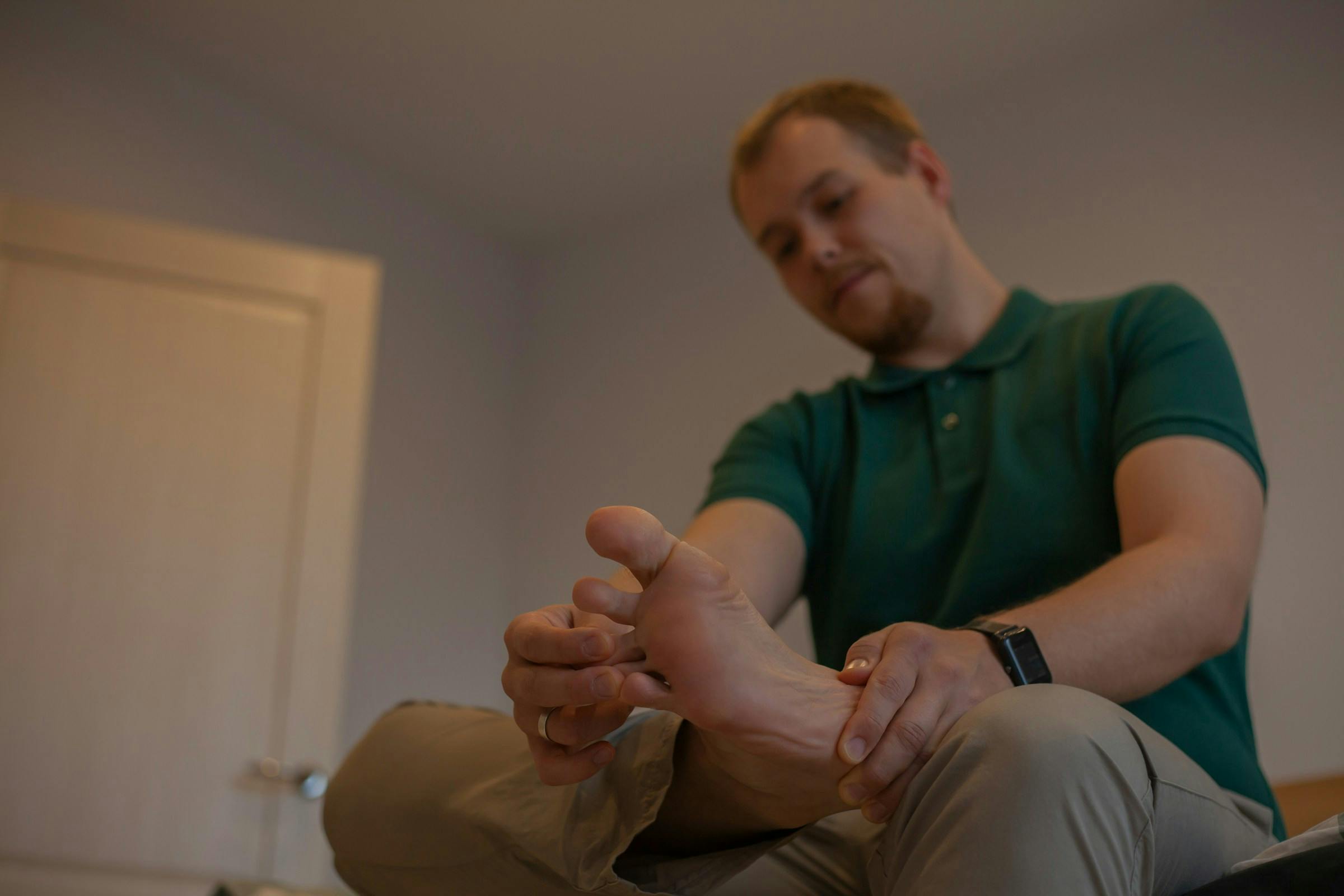How to Get Rid of Wrinkled Feet: 5 Proven Ways to Smooth and Rejuvenate Your Skin
By Dr. Jossy Onwude, MD
Reviewed by Dr. Daniel Uba, MD
Published Apr 17, 2025
10 min read

Have you ever looked down at your feet and thought, “Wait a minute… when did they start looking so old?” You're definitely not alone. Wrinkled feet can sneak up on anyone, whether you're always on the go, walking barefoot at home, or even just getting older (as we all do). But here’s the thing: while aging is natural, rough and wrinkly feet don’t have to be.
Just like the skin on your face or hands, the skin on your feet can lose collagen, dry out, or get damaged over time. But most people don’t pay attention to foot care until problems show up. That’s why we’re here—to walk you through five simple, science-backed strategies that can help you reduce foot wrinkles, make your skin smoother, and even prevent those lines from coming back.
Whether you’re a skincare junkie or someone just trying to feel a bit more confident in sandals, this guide will give you all the tools you need. Let’s start from the bottom—literally.
Understand Why Feet Wrinkle: The Root Causes
Before we jump into the how-to part, it’s helpful to understand why your feet may be looking more wrinkled than you’d like. Wrinkles on your feet happen for many of the same reasons you get wrinkles elsewhere: your skin changes with age. But your feet also face some unique challenges.
As you get older, your skin produces less collagen and elastin—two proteins that help keep it firm and bouncy. Without them, the skin becomes thinner, looser, and more likely to wrinkle. This process is totally natural and is called intrinsic aging, meaning it happens inside the body.
But there’s another kind of aging called extrinsic aging, which is caused by things outside your body. Think about how often your feet are exposed to the sun in sandals or how much pressure they endure from standing or walking all day. These external stressors—like UV rays, friction from shoes, and even poor hydration—can speed up the aging process and cause premature wrinkles on your feet.
Even your environment matters. If you live in a dry climate or spend time in air-conditioned rooms, your skin might be losing moisture faster, making it more prone to creasing and cracking.

In short, wrinkled feet are usually the result of a few things working together:
- Loss of collagen and elasticity due to aging
- Frequent exposure to the sun without protection
- Dehydrated skin (either from not moisturizing or drinking enough water)
- Constant pressure and friction from shoes or walking barefoot
- A lack of regular foot care
The good news? Most of these factors can be managed or even reversed with the right habits.
1. Exfoliate Gently But Regularly
If you’ve never exfoliated your feet before, you’re missing a key part of keeping them smooth and healthy. Think of exfoliation like hitting the “refresh” button on your skin. It removes dead skin cells that pile up on the surface, which can make wrinkles look worse and make it harder for moisturizers to do their job.
When your feet feel rough or look dull, it's often because of built-up dead skin. That buildup can settle into fine lines and deepen the appearance of wrinkles. Regular exfoliation can help your skin look brighter, feel softer, and stay healthier overall.
There are two main ways to exfoliate your feet:
- Physical exfoliation, like using a foot scrub, pumice stone, or foot file to manually remove dead skin.
- Chemical exfoliation, which uses gentle acids like AHAs (alpha hydroxy acids) or BHAs (beta hydroxy acids) to break down dead skin cells without scrubbing.
You don’t need to scrub your feet raw. In fact, overdoing it can actually cause irritation or make your skin more prone to injury, especially if you have sensitive skin or conditions like diabetes.
For most people, exfoliating 1–2 times a week is plenty. After exfoliating, be sure to rinse well and follow up with a rich moisturizer to lock in hydration and protect your newly revealed skin.
Pro tip: A warm soak in Epsom salt water before exfoliating can help soften calluses and make the process easier and more relaxing.
2. Hydration is Key: Moisturize Like You Mean It
Moisturizing is probably the most important thing you can do to reduce and prevent wrinkles on your feet. Why? Because dry skin loses flexibility and strength. When your feet are dry, small lines and creases become more noticeable, and your skin can even start to crack.
Think of your skin like a sponge. When it’s dry, it shrinks and stiffens. When it’s hydrated, it plumps up and softens. That’s why applying a good moisturizer, especially after exfoliating or showering, can make such a big difference.
But not all moisturizers are created equal. For wrinkled feet, you want a combination of:
- Humectants, like glycerin and hyaluronic acid, which pull water into the skin
- Emollients, like shea butter or ceramides, which smooth and soften
- Occlusives, like petroleum jelly or lanolin, which seal in moisture and prevent water loss
One simple trick is to apply your moisturizer at night and then wear cotton socks to bed. This helps the product stay on your skin longer and gives it time to soak in while you sleep.
If your heels are extra dry or cracked, look for creams that contain urea or lactic acid—they not only hydrate but also gently exfoliate rough patches. You can also try using hydrating foot masks once a week for a deeper treatment.
Don’t just moisturize when your feet feel dry—make it a regular part of your routine, just like brushing your teeth.

3. Protect from the Elements: SPF and Footwear Matter
Here’s a question: When’s the last time you put sunscreen on your feet? If you’re like most people, the answer is probably “never.” But the tops of your feet are often exposed to the sun, especially in warm weather or when you wear sandals. And guess what? UV exposure is a major contributor to wrinkles.
Sun damage doesn’t just cause burns. It breaks down collagen and elastin in your skin, which leads to sagging, thinning, and fine lines. So, the next time you're heading out in open-toed shoes, don’t forget to apply a broad-spectrum sunscreen with at least SPF 30 to the tops of your feet (and even your ankles). Reapply every couple of hours if you’re outside for a long time.
Sun protection is just one part of the puzzle. Footwear also plays a huge role in keeping your feet wrinkle-free.
Wearing shoes that are too tight can cause friction and pressure, which stresses your skin. On the flip side, walking barefoot all the time—especially on hard or hot surfaces—can also damage the skin’s outer layer and increase your risk of dryness and wrinkles.
Your best bet? Choose comfortable, breathable shoes that support your feet and give them room to move. And if you’re lounging at home, consider wearing socks or soft slippers instead of going barefoot on cold or rough floors.
Little changes like these can go a long way in preserving your foot skin’s health and appearance.
4. Boost Collagen and Skin Renewal from Within
Wrinkles happen when the skin loses collagen and elasticity. While moisturizing and protecting your feet can help, real change also happens beneath the surface. That’s where collagen-boosting treatments and lifestyle choices come in.
Let’s start with topical treatments. Ingredients like retinol, vitamin C, niacinamide, and peptides can encourage your skin to produce more collagen and repair damage. While most people use these ingredients on their face, there’s no reason you can’t apply them to your feet too, especially if you notice fine lines, thinning skin, or a loss of firmness.
Start slowly, especially with strong ingredients like retinol. Apply a small amount every few days and always follow with a good moisturizer. If your skin gets red or irritated, take a break and go back to basics.
Next, consider your lifestyle habits. A healthy diet rich in vitamin C, zinc, protein, and omega-3s can support your body’s natural collagen production. Drinking enough water is also key—hydrated skin looks smoother and more youthful.
If you smoke, know that it significantly reduces blood flow to the skin and speeds up the aging process—not just on your face but all over, including your feet.
Some people also explore professional treatments, like microneedling or LED therapy, which can boost collagen and improve skin texture. If you're curious about those, speak with a dermatologist or licensed skincare professional.
In short: support your skin from the inside and out. Your feet deserve it just as much as your face.
5. A Simple Daily Footcare Routine
If all of this sounds like a lot, don’t worry. You don’t need to spend hours every day on your feet. A basic, five-minute daily routine can go a long way.
Here’s a simple plan:
- In the morning: After your shower, pat your feet dry and apply a lightweight moisturizer. If you’re wearing open shoes, don’t forget the sunscreen.
- In the evening: Wash your feet with warm water, gently exfoliate if needed (2–3 times per week), then slather on a thick cream. Pop on some cotton socks before bed.
- Weekly: Use a foot mask or do a deep moisturizing treatment.
Consistency is everything. Once this becomes a habit, your feet will start to feel and look better with time—smoother, softer, and less wrinkled.
Final Thoughts: Aging is Natural, But Wrinkled Feet Don’t Have to Be
Let’s face it—our feet don’t get the love they deserve. We put them through so much every day, and yet they’re often the last part of our bodies we think to take care of. But with just a little attention and the right steps, you can keep your feet looking as youthful and smooth as the rest of you.
Whether you’re trying to reduce the wrinkles you already see or prevent them from showing up in the first place, the strategies we’ve covered—exfoliation, hydration, sun protection, collagen support, and smart footwear—can make a real difference.
So go ahead. Pamper your feet. Put on that foot cream. Wear sunscreen. Your future self will thank you.
Want more skin-smart tips and easy wellness advice like this? Stick with meto.co for down-to-earth guides that help you feel your best, from head to toe.
Frequently Asked Questions (FAQs)
1. Why do my feet look wrinkled all of a sudden?
Sudden wrinkles on your feet can be caused by dehydration, sun exposure, or even weight loss, which can reduce the fat padding on your feet. If you’ve recently spent a lot of time barefoot, in the sun, or in water (like swimming or bathing), these factors could temporarily wrinkle your skin. Consistent skin care, including moisturizing and sun protection, can help.
2. Can I use face products like retinol or vitamin C serum on my feet?
Yes, you can! The skin on your feet can benefit from collagen-boosting ingredients like retinol and vitamin C, especially if you have wrinkles or thinning skin. Just be sure to apply these products sparingly and follow up with a rich moisturizer to prevent irritation. If you have sensitive skin, start with low concentrations.
3. Is it normal to have wrinkled feet as you age?
Yes, it’s completely normal. As we age, our skin naturally produces less collagen and elastin, which causes it to become thinner and more prone to wrinkles, feet included. Aging feet may also lose fat padding, making bones and veins more prominent. However, regular care can help slow down this process and improve the skin's texture and appearance.
4. Do wrinkled feet mean I have a health problem?
In most cases, wrinkled feet are simply a sign of aging or dry skin. However, if your foot wrinkles are accompanied by other symptoms like swelling, pain, color changes, or sores that won’t heal, it could point to an underlying medical condition. If you’re concerned, it's a good idea to talk to a healthcare provider or dermatologist.
5. How long does it take to see results from foot care routines for wrinkles?
With consistent care—including exfoliating, moisturizing, and sun protection—you may start to see noticeable improvements in skin texture within a few weeks. Deep wrinkles or dry patches might take a bit longer to smooth out, especially if you've neglected foot care in the past. Be patient and stick with your routine.
Share this article

What Is Premature Aging and What Can You Do to Prevent or Reverse It?
Dr. Priyali Singh, MD
Sep 28, 202510 min read

Low Sodium Diet: Simple Guidelines, Food Lists, and Tips for Better Health
Lilian E.
Sep 30, 202512 min read

Tips for Staying Healthy: 12 Simple Habits for Energy, Longevity, and Better Living
Editorial Team
Sep 30, 202510 min read

Best-in-class care is a click away
Find everything and everyone you need to reach your metabolic health goals, in one place. It all makes sense with Meto.
Join Meto